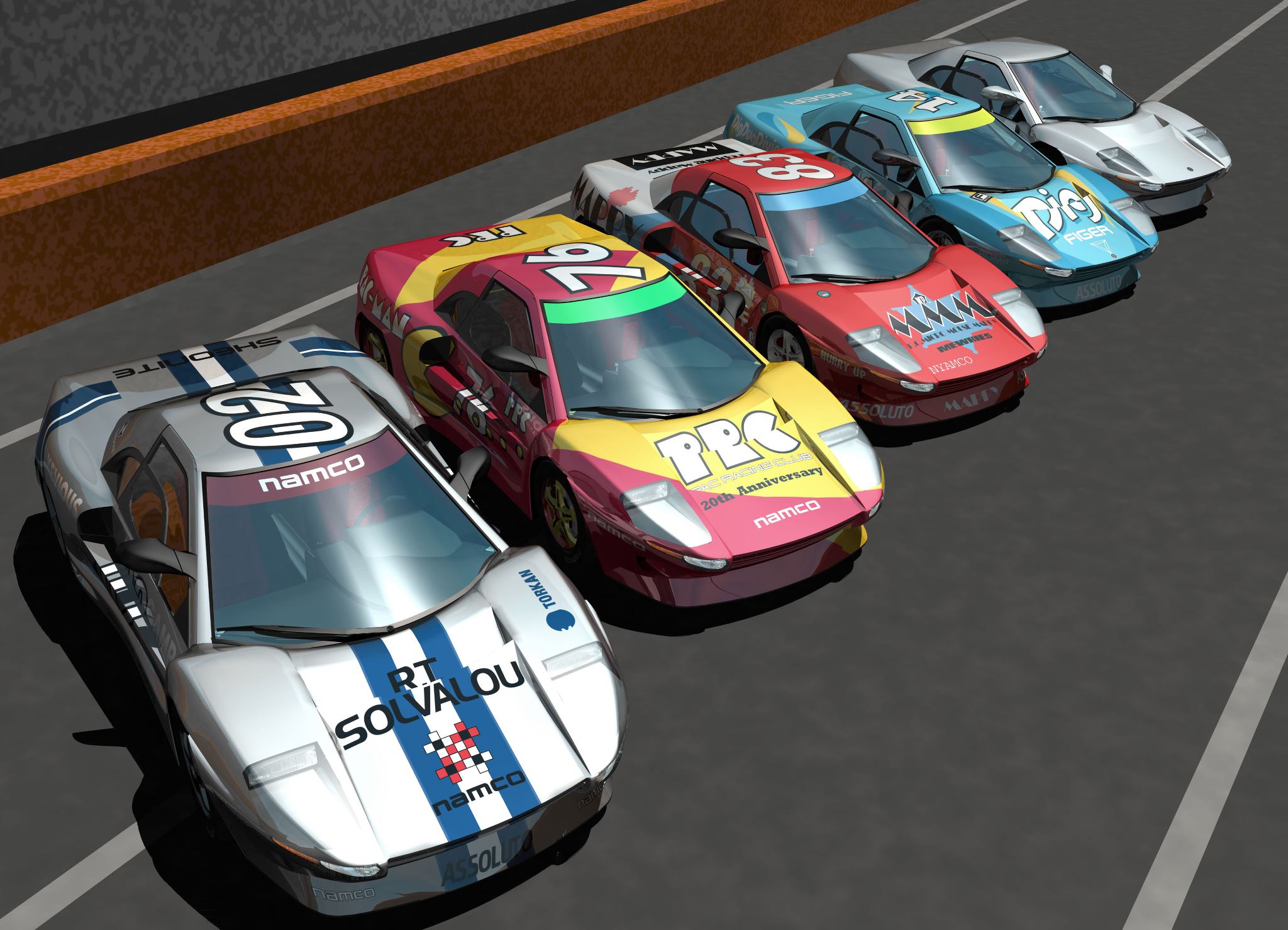Ridge Racer: A Series Retrospective - In the Beginning
Launching a console and an arcade racing giant

If you owned a launch-window console in the mid-’90’s through to the late ‘00s, you likely know exactly what Ridge Racer was about: simple, fast, exhilarating arcade racing action. It might not be the deepest or most complex game around, but you could guarantee it would quickly get you into the action with your new console and with stylish graphics to get your new hardware earning its price tag. But, in 1995, Sony was the new kid on the block and Ridge Racer was so much more than a simple racing game.
Riiiiidge Racerrrrr!
At that year’s E3, Sony needed to make a serious first impression if it hoped to stand up against Sega and Nintendo. It's safe to say they delivered in multiple ways - I can’t resist mentioning Steve Race, the head of development, who famously responded to the Sega Saturn’s $399 price tag by simply stepping up to the podium, saying ‘$299’ and immediately walking offstage again.
But the price isn’t everything, and Sony intended to impress with some serious technological leaps. Enter Ridge Racer, the blazing-fast 3D racing game which had drifted into arcades across the world just over a year prior. In a time when “arcade port” usually meant a reduced reproduction or, at worst, waiting half a decade for a console powerful enough to run it, Ridge Racer was promising arcade-perfect 3D racing less than two years after the arcade original hit the States. The closest consoles had ever gotten prior to this was probably Virtua Racing on the Mega Drive/Genesis but with a PowerPoint framerate and untextured polygons, it was hardly fair to line it up next to Ridge Racer.
All of this is central to understanding how Ridge Racer came from nowhere and accelerated straight to the top, cementing its status as the showcase game for new consoles for decades to come. For early adopters of Sony’s plucky little upstart console, this was the game best representing the speed and exhilaration 3D gaming had the potential to deliver. Ridge Racer would enjoy a few more years in the limelight, but it never quite managed to repeat the glamorous peak of that E3 reveal and its podium finish on the PlayStation’s launch window lineup.

A slew of minor updates
Namco would spend the next few years constantly tweaking but rarely innovating. The arcades received two sequels before the original even hit western PlayStations. Well, sequels were how Namco described them, but ‘revisions’ might be a more accurate term. Ridge Racer 2 was released in June 1994 and, despite its grandiose name, featured the exact same cars, tracks, and graphics. At least the soundtrack was all new, though some were remixes of the original. A rearview mirror was also added and some tracks transitioned from night to day mid-race. That last feature is admittedly pretty neat.
In July 1995, the beautifully 90’s-named Rave Racer hit the arcades. This was still a revision of the original game, but this time in a cooler Street Fighter II sort of way - featuring two extra tracks, improved handling and marginally improved graphics. And another new soundtrack, because it isn’t Ridge Racer without fresh 90’s dance beats to listen to.
The final iteration of classic Ridge Racer was Ridge Racer Revolution. This PS1 exclusive, released in Japan only three months after the original game hit Western consoles, could easily fool you into thinking this is yet another basic revision of the first game. But, while the graphics and the cars and the decor all look the same, all tracks are brand new. Three whole new tracks shouldn’t be this exciting, but it was a big step forward for the series. Especially since the original game only had two tracks spread over three levels, meaning two of them shared a track.
I’m being quite negative towards these games, but don’t let this trick you into thinking these aren’t some of the most fun arcade racers around. Ridge Racer is still Ridge Racer, and I could play any of these games for hours. But still, it’s important to show that Namco was doing little to offer more to the Ridge Racer fan at this time, and by the time Revolution hit the US in September 1998, the graphics were starting to look dated.
Critics were beginning to turn away from the series. Edge Magazine noted that it was ‘virtually indistinguishable' from the original game, and Next Generation Magazine went as far as to say that owners of the first release would feel ‘a half-step away from being conned’. It's safe to say that Namco had to start innovating, and fast.

A shift towards realism
Keeping up with the yearly releases, Rage Racer dropped in Japan exactly a year after Revolution, but this time there was little in common with its predecessors. Dropping all the previous tracks, this game brought three entirely new racetracks with a more gritty, realistic (read: grey) tone in place of the iconic sunny skies and bouncy beats of the original. This was a Ridge Racer for the mature audience Sony was gathering for the PlayStation, and it shows in every aspect of the visual design.
By far the most interesting change, however, is the introduction of something closer to a career mode. Featuring multiple championships requiring cars of different performance classes, Rage Racer expected the player to earn credits to pay for new cars or upgrade their existing cars in order to stay competitive in higher leagues. If this sounds familiar, I would like to gently point out that Rage Racer came out a whole year before Gran Turismo.
It even featured a proto-tuning feature, allowing players to adjust a ‘Grip/Drift’ slider which would affect how easy it was to drift around corners, in exchange for sharper handling. Very forward-thinking indeed, and while the general feel and the graphics engine were not much of an upgrade from Revolution, it was clear that Namco was slowly but firmly pushing Ridge Racer closer towards the not-yet-coined genre of racing simulation.
By this point, it was becoming a regular occurrence for a new Ridge Racer to drop on Japanese consoles in December, but Namco decided to skip a year in ‘97. And probably for the best, since December 1997 saw the release of Gran Turismo and essentially rendered all previous racers obsolete. Namco really needed to step up their game this time.

And step up they certainly did. R4: Ridge Racer Type 4 was released in December 1998 after a two-year development cycle, and is considered by many to be the pinnacle of the franchise. Truly reinventing the series, R4 had all new cars, eight (eight!!) entirely new tracks, and a short but highly replayable career mode, complete with quaint visual novels sections delivering a barebones story in-between races. These stories aren’t exactly Shakespearean, but they ooze with charm.
But perhaps they only ooze charm because of the game’s stellar visual presentation. This is where R4 is truly in a league of its own. Before you even enter a race, the menus warmly greet you with a sleek, minimalist class that could easily make you forget this game is over 20 years old. When you finally do manage to wrest your eyes from the menus, the races will slap you with some of the finest graphics on the PS1. There aren’t many games from this era that can safely say they’ve held strong against the test of time, especially games which aim for realism, but R4 looks absolutely stunning even today, largely due to very clever use of lighting and shading.
Namco made sure to mention Gouraud shading as much as possible in the marketing and even in the manual. Like most people reading about it in the 90s, I am far from clever enough to understand exactly what Gouraud shading is, and yet the difference is obvious the moment you enter the game. Previous games in the series had noticeably flat lighting. Every surface was fully and evenly lit, with no gradients or shadows. R4 can take advantage of coloured lighting and proper shading on textures so, naturally, Namco went whole-hog on integrating this tech into their track designs.
From gloomy yellow-lit tunnels in midnight races to dawn rising over the peaks of a mountaintop track, R4 expanded on the traditional settings of previous Ridge Racer tracks and absolutely drenched them in atmosphere. It was all aided by a stellar soundtrack, swapping the big beat 90s house tracks of previous games for a calmer, almost ethereal acid jazz that gently sweeps you along the winding tracks.

R4 is the culmination of everything that came before it, finding a subdued pastel-coloured art style somewhere in between Ridge Racer’s primary colours and Rage Racer’s… complete lack of it. Career mode returned to a more arcade-style, races-as-levels structure, but kept the distinction between drifting and grip handling from Rage Racer. If there is one Ridge Racer you should play, it is absolutely this gem. Other games in the series might have had a bigger impact on the gaming industry, but this one is the masterpiece.
Sadly, it’s arguable that Ridge Racer would never make a true masterpiece again. While many great games were yet to come, hindsight shows that the new millennium dawned with nothing more than a gradual decline for the racing launch-title giant. But that’s a story for the next article, where I’ll cover the solid highs and embarrassing lows of Ridge Racer’s post-peak career.
